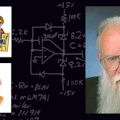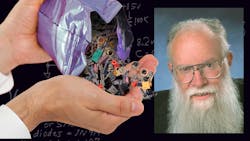What's All This April Floobydust Stuff, Anyhow? (Part 12)
This article is part of Bob Pease's Floobydust series found in the Electronic History section of our Series Library.
Since it's now June, you can consider this my April Fools' joke. And now on to the latest Floobydust items: There's a new educational facility on the Web, called Analog University, from National Semiconductor. It supplies good teaching materials on several linear and analog topics, as well as op amps, voltage regulators, and so forth. It has material on advanced, intermediate, and basic levels. It provides video lectures, Q&A, quizzes, and tests. Plus, it has a pretty good natural-language search engine and a knowledge base. If you have a question about something analog, and it doesn't make sense to you, try this out.
This is not just for analog-circuit design engineers. It helps any engineers who must learn how to do some linear circuits. Its purpose is to provide improved time-to-learning for people who have to design linear circuits with fast time-to-market. It's not just for NSC engineers, nor for NSC customers. It's for everybody, which means not just engineers. It's very good for technicians too. And who is the Dean of Analog University? RAP is the Dean. No fooling. You can check it out at www.national.com/analogu.
If you look in this book under "Sound Pressure," you can learn that the reference point known as "0 dB" is really at 20 micropascals, which is about 2.90 nano psi (pounds per square inch). (It's actually 2.908, if you care, about 0.002 dB of accuracy.) Thus, the number of dB that corresponds to + and -1 atmosphere of peak pressure, or ±14.7 psi peaks, is about 191.1 dB. So when a sine wave of sound gets to that level, the peak pressure would be double atmospheric pressure, and trough pressure would be about zero, which is hard to generate or imagine.
PITCH How many of you guys have noticed this? You are listening to music, or even the pitch of your computer's fan, or a dial tone. Then as you bite down hard on some tough nuts or a popcorn cake, the pitch seems to dip momentarily by about half a note. I hear this plainly. Try it.Doppler shift has a similar effect and is well understood, but it's quite different. Audio experts can give me no theories on why the number of cycles arriving at your ear (per second) seems to be changing when it isn't! Do you hear it?
Read What's All This Floobydust Stuff, Anyhow? (Part 13)
Comments invited! [email protected] —or:
Mail Stop D2597A, National Semiconductor
P.O. Box 58090, Santa Clara, CA 95052-8090
About the Author

Bob Pease
Bob obtained a BSEE from MIT in 1961 and was a staff scientist at National Semiconductor Corp., Santa Clara, CA, for many years. He was a well known and long time contributing editor to Electronic Design.
We also have a number of PDF eBooks by Bob that members can download from the Electronic Design Members Library.
